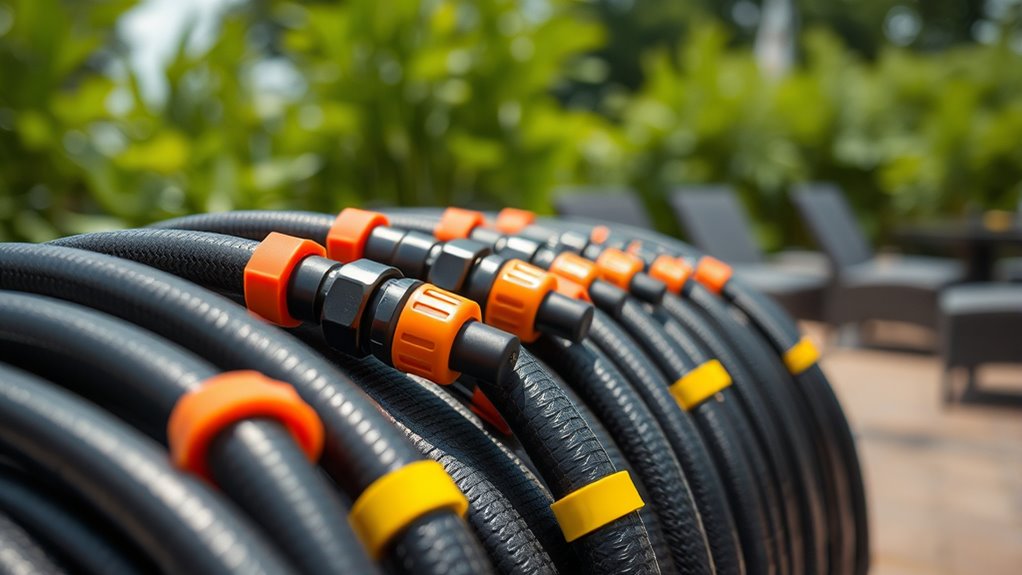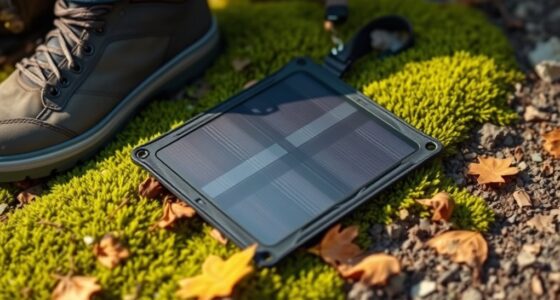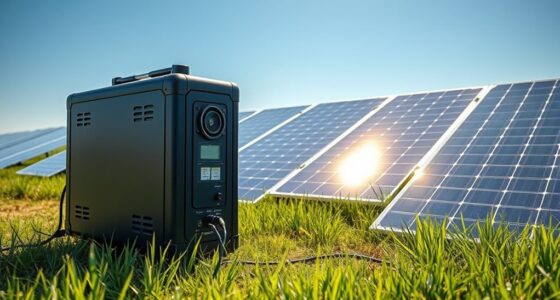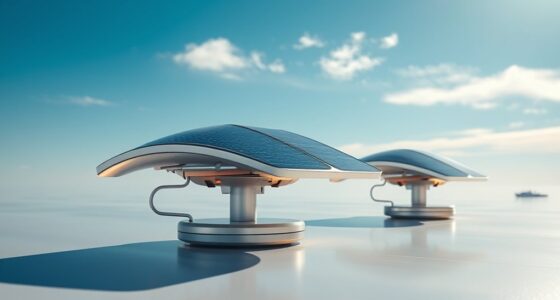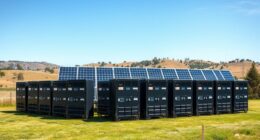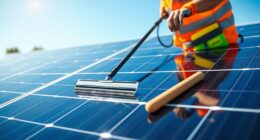To safely power your outdoor setup, use weatherproof cables designed to resist moisture, extreme temperatures, and physical stress. Choose high-quality cables with tough insulation and protective jackets made from UV-resistant materials like rubber or PVC. Proper installation is key—secure cables well, avoid sharp objects, and use weatherproof connectors. Regularly inspect and maintain connections to prevent damage. Keep these tips in mind, and you’ll guarantee a durable, safe outdoor electrical system. There’s more to uncover for long-lasting protection.
Key Takeaways
- Choose cables made from weather-resistant materials like rubber, PVC, or polyethylene to withstand outdoor environmental conditions.
- Use specialized weatherproof connectors and junction boxes to prevent moisture ingress and ensure secure connections.
- Properly plan installation by securing cables, avoiding sharp objects, and burying underground cables at appropriate depths.
- Regularly inspect and seal all joints and connections with waterproof sealants to prevent water damage and corrosion.
- Invest in high-quality, durable cables and correct installation techniques to enhance safety, longevity, and reliable outdoor power supply.
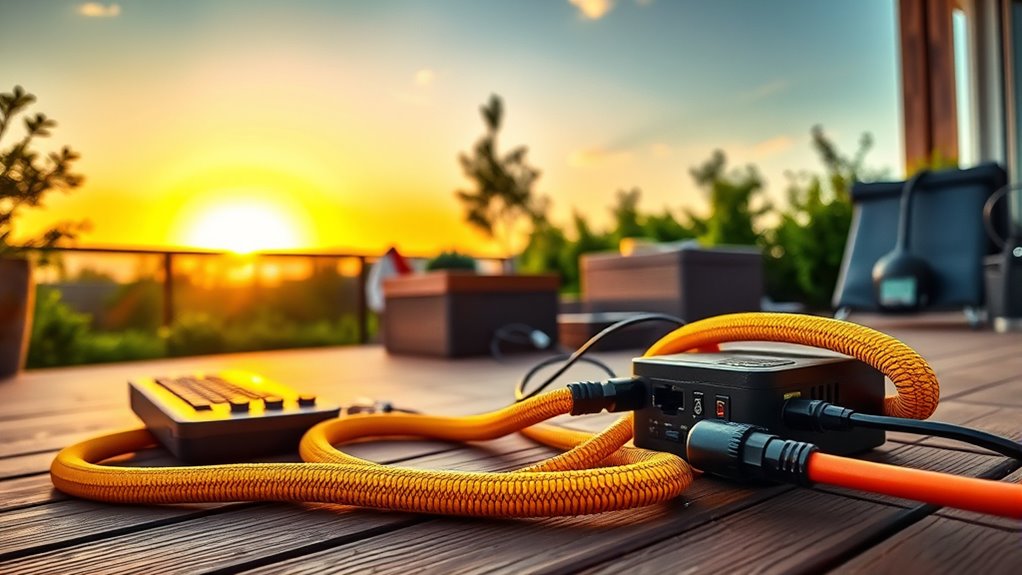
Weatherproof cables are designed to withstand harsh environmental conditions, making them indispensable for outdoor electrical setups. When installing these cables, you need to pay close attention to the installation tips to guarantee they perform reliably over time. Proper installation is key to preventing damage and maintaining safety, especially in areas prone to moisture, extreme temperatures, or physical stress. Start by choosing cables with high material durability; look for those with robust insulation and protective jackets made from weather-resistant compounds like rubber, PVC, or polyethylene. These materials are engineered to resist UV rays, water intrusion, and temperature fluctuations, which are critical factors in outdoor environments.
Before installation, plan your route carefully. Avoid areas where cables could be exposed to sharp objects, heavy foot traffic, or potential physical impacts. When laying out your cables, ensure they are buried deep enough if underground or secured tightly if run along surfaces or structures. Use appropriate clips, staples, or conduit fittings to keep the cables in place and prevent unnecessary strain on the connections. This not only prolongs the lifespan of the cables but also minimizes the risk of accidental disconnections or damage. Additionally, using proper installation techniques can significantly enhance the longevity and safety of your outdoor wiring system.
Another essential installation tip involves sealing and protecting connections. Weatherproof cables often come with specialized connectors or junction boxes designed to keep moisture out. When connecting different sections or devices, make sure to use these weatherproof fittings and seal all joints thoroughly with waterproof tape or sealants. This step is critical because even small gaps can allow water ingress, leading to corrosion and electrical failures. Additionally, regularly inspect your setup for signs of wear or damage, especially after severe weather events, and address issues promptly to maintain safety.
Material durability plays an indispensable role in how well your cables withstand outdoor conditions. Investing in high-quality, durable cables might cost more initially but saves you money and hassle in the long run. Cheaper cables often use inferior insulation that cracks or deteriorates quickly, exposing conductors to the elements. Durable weatherproof cables, on the other hand, are built with layered protections and tough outer shells that resist environmental stressors. This resilience ensures your outdoor setup remains safe, functional, and compliant with electrical standards, even after years of exposure.
Ultimately, choosing the right cables and following proper installation tips will give you peace of mind, knowing your outdoor electrical connections are protected against the elements. Prioritize material durability and careful planning during installation, and you’ll enjoy a safe, reliable outdoor power setup that stands the test of time.
Frequently Asked Questions
Can Weatherproof Cables Be Used Underwater Safely?
You might wonder if weatherproof cables can be used underwater safely. For underwater cable installation, it’s essential to use specialized waterproof connector types designed for submersion. Regular weatherproof cables aren’t meant for underwater use, so choose cables rated for direct contact with water. Always guarantee your connections are sealed properly with appropriate waterproof connectors, and follow manufacturer guidelines to prevent damage and ensure safety during underwater installations.
How Often Should I Inspect Outdoor Cables for Damage?
You should inspect your outdoor cables regularly, ideally every three to six months, to catch any damage signs early. Look for cracks, fraying, or corrosion that could compromise safety. Increased inspections are necessary after severe weather or if you notice any issues. Staying vigilant helps prevent electrical hazards and guarantees your setup remains safe and functional over time. Consistent checks protect both your equipment and your safety.
Are There Specific Certifications for Outdoor Weatherproof Cables?
Ever wondered if your outdoor cables meet safety standards? Yes, there are specific certifications for weatherproof cables. Look for certification standards like UL, IP ratings, and weatherproof markings to confirm durability and safety. These markings guarantee your cables are designed to withstand outdoor elements. Don’t take chances—always verify these certifications before powering your outdoor setup to protect your equipment and ensure safety.
What Is the Maximum Length for Safe Outdoor Cable Extension?
The maximum length for safe outdoor cable extension depends on extension limitations and safety guidelines, which aim to prevent voltage drops and electrical hazards. Typically, you should limit extension cords to 50-100 feet for standard outdoor use. Longer runs can cause power issues and safety risks. Always check the manufacturer’s recommendations and use outdoor-rated, weatherproof cables to make certain of safe, reliable power supply for your outdoor setup.
Can Weatherproof Cables Be Exposed to Direct Sunlight Long-Term?
They say, “A stitch in time saves nine,” and that applies to your outdoor cables. You can leave weatherproof cables in direct sunlight long-term, but beware of UV resistance and thermal degradation. Over time, exposure can weaken the insulation, risking damage or failure. Choose cables with high UV resistance to prolong lifespan, and regularly inspect them to guarantee safety and performance.
Conclusion
Just as a sturdy ship withstands stormy seas, weatherproof cables shield your outdoor setup from the elements. They act as the vigilant crew, guarding your connections against rain, wind, and dust, ensuring your devices stay powered and safe. With these cables, you’re steering your outdoor space with confidence, knowing you’ve built a resilient vessel that can weather any storm. Embrace weatherproofing, and let your electrical journey sail smoothly through all conditions.
